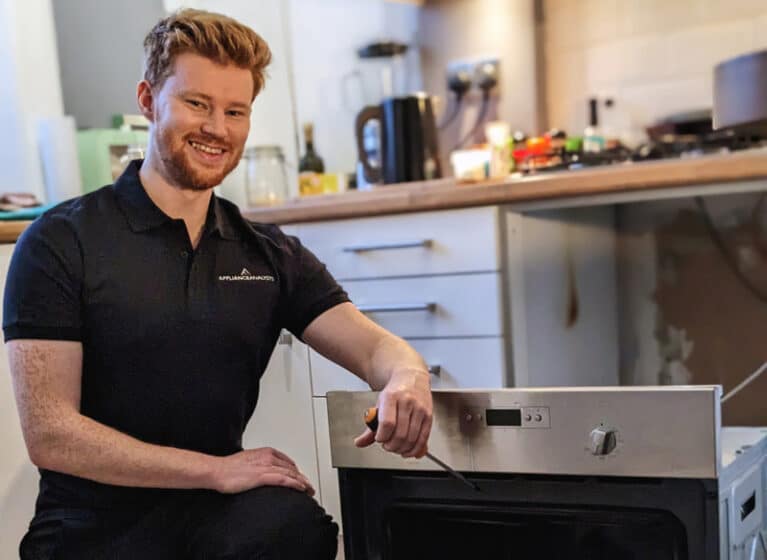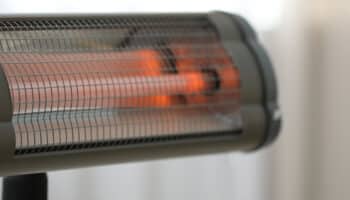We've independently reviewed this article to make sure it's as accurate as we can make it.
To find out more about our article creation and review process, check out our editorial guidelines.
Are you having a hard time comparing infrared vs convection heaters?
Don’t worry, this is a common issue. With so many technical terms and information out there, it can be tough to figure out which type of heater is right for your needs.
The good news is that you’ve come to the right place for answers!
Infrared heaters warm up objects and people, making them more expensive to buy but cheaper to run. Convection heaters, on the other hand, warm up the air. But, this heat can be lost through a draft or open door, making them cheaper upfront, but expensive to run.
Read on to learn more about the differences between infrared vs convection heaters!
Infrared vs Convection Heaters
To make things easier, I’ve put together a list of the main differences between these two types of heaters.
Try to consider which aspects are most important to you. Knowing this can make it clearer which type of heater will be better for you, personally.
#1 Price
One of the main differences between infrared and convection heaters is their price.
Although this may vary depending on the model and brand you choose, a standard convection heater typically costs less than a standard infrared heater.
For a basic model to ‘get the job done’, you’re looking at $40-$70 for a convection heater, but $60-$140 for an infrared.
Bear in mind that while infrared heaters are typically more expensive to purchase upfront, they can be cheaper to run in the long term. Keep reading to learn more about this!
#2 Cost to Run
Running costs is where things go beyond the basics.
Out of all space heaters, infrared is the cheapest to run. The type of heat produced uses much less electricity than that of a convection heater.
So while they may cost more upfront, infrared heating will save you money in the long run.
Want to know more? Check out this guide to know how much your electric heater probably costs to run.
#3 Type of Heat
These two heaters produce heat differently.
Convection heaters work by warming up the air in the room. They use a heating element to diffuse heat into the surrounding air, and a fan to circulate the warm air throughout the room.
This is great for an enclosed, insulated space with minimal ventilation. However, it’s very easy to lose that heat through drafts or open doors.
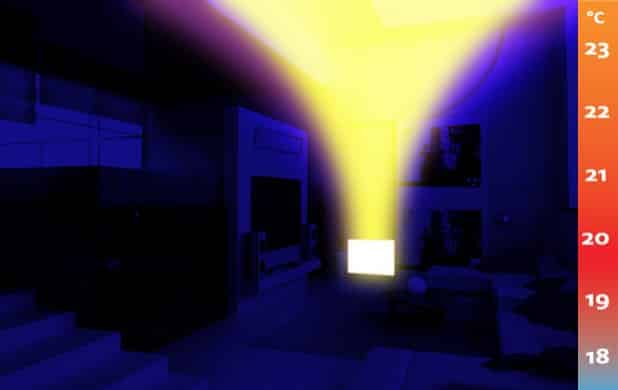
Infrared heaters heat up objects. Just like the sun, they provide heat through radiation – heating up whatever is directly in the line of sight of the heater. Including us!
This means infrared heat doesn’t get lost if there’s a cold breeze – it’s a much more durable heat. If you’re looking for a more natural way to heat your home, consider using a wood burning stove.
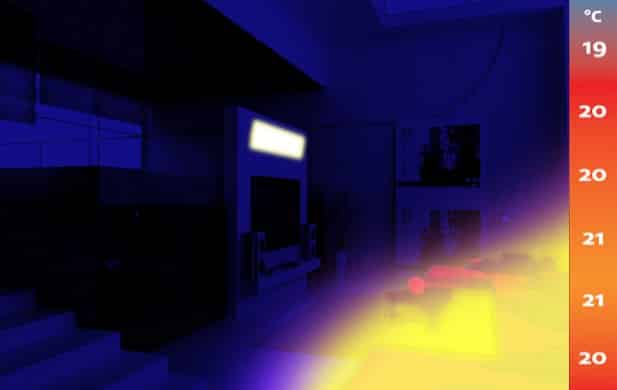
Does ‘radiation’ sound scary? Don’t worry – it’s not! Check out our guide to ‘Are infrared heaters safe?’ if you’d like to find out why.
#4 Noise
If you work from home or have kids, I’m sure you’ll agree that having a silent heater is crucial.
Luckily, both heaters are typically silent.
It’s worth mentioning that convection heaters may produce a bit more noise compared to infrared heaters because some models use a fan to circulate warm air throughout the room. However, the noise level is generally low.
Infrared heaters are also entirely quiet, aside from a small ‘hum’ on startup.
#5 Safety / Child-Proof
Both of these heater types can get very, very hot.
With infrared, the heat is applied to whatever is in front of the infrared heating element… including the grill of the heater itself! This can be dangerous with kids or pets around.
Thankfully, good modern models often have heat-proof exteriors (like Vornado’s infrared heater) or can be mounted in out-of-reach places.
Convection heaters are also able to cause a burn. While traditionally most are recognizable as heaters, some modern models are so sleek they look like an electronic gadget.
In this case, both options will need a little bit of thought if your home is full of kids (or curious pets).
#6 Installation Options
Have you ever seen infrared panel heaters? They’re incredible.
Appearing as wall art, mirrors, or even a minimalistic wall panel, they can be installed on the wall and blended into your surroundings. It’s as if you don’t even own a heater. Other options are, of course, standard wall/ceiling mounted grill types of heaters.
These wall-mounted options are so prevalent with infrared because the type of heating relies on a good line of sight. They only heat what’s in front of them, so they’re naturally focused around being mounted higher up.
On the other hand, convection heaters are much more traditional. It’s rare to get a model which doesn’t take up some of your floor space – and they always look like standard heaters.
#7 Ease of Use / Control
Despite infrared being wall-mounted and interesting, they don’t offer much control. Their heat is typically limited to just ‘on or off’, and not controlled by a thermostat like convection heaters are.
Infrared heaters also typically have fewer features like timers or programmable settings.
On the other hand, a good convection heater has as many settings as a car! (Which is great if you have the time to learn them all, or a bit frustrating if you just want a simple heater).
Infrared vs Convection Heaters: Pros & Cons
Sometimes the best way to compare two options is to weigh up their pros and cons. I’ve listed all major points for both heater types below.
| Pros | Cons |
|---|---|
Electric Convection Heaters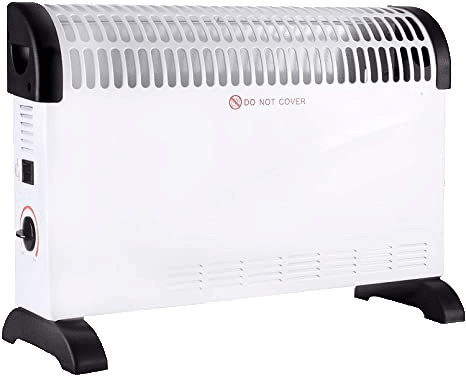 |
|
| Cheaper - With such a mass-manufactured product, there's tons of competition which means cheap prices. Great if you're looking for a quick bit of extra heating power. | Quick Heat Loss - Since these heaters rely on spreading heat through the air, any bad insulation or drafty windows will make you lose the heat fast. |
| Faster - Electric fan heaters heat up a room in minutes. Their fans quickly spread the heat throughout the air of the space. | Higher Bills - Due to the quick heat loss, standard electric heaters need to provide higher heat for longer - costing more energy. |
| More Options - There are thousands of thousands of models to choose from. You're more likely to find a model that is perfect for your taste. | Inaccurate - Unless you've got a real high-end model, standard convection heaters aren't as good at keeping one constant temperature. They typically end up going a bit too hot or not hot enough, and need you to fiddle with the controls every so often |
| Safer for Kids - Most standard fan heaters aren't overly hot to the touch, and the noise makes it more obvious that it's on (and hot!) | |
Infrared Heaters 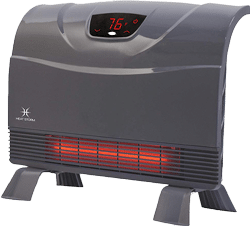 |
|
| Cheap to Run - Infrared heaters are typically the cheapest type of heater to run. They use less watts in general, and don't need to work extra hard if a space is draughty. | Only on/off - One downfall of infrared heaters is you can't quiet control the temperature. It's typically either just on or off, and with only 2 or 3 power settings. This can make things tricky if you're really looking for a perfect room temperature. |
| Silent - Aside from some heating noise on start-up, infrared heaters are mostly silent. Perfect for bedrooms. | Can get hot / kids touch - Lastly, these guys do get really hot when on high power. If you've got any kids or curious pets, be careful! A great alternative is having them on the wall, out of reach of inquisitive hands/paws. |
| Heat Lasts - Since they heat objects and not the air, a cool breeze or an open door won't mean you lose all of that heat. | |
| Wall Options - There's tons of creative options for infrared heaters. The latest take are simple, minimalistic panels that sit on the wall and gently heat the whole room. They can even come as art pieces, or mirrors! | |
| Gentle, instant heat - One of the most satisfying things about these heaters is that they're both instant, but gentle. When you turn them on you feel the heat immediately, but that same heat doesn't then get too much (since the objects are warm, not the air). | |
What’s Best For…
Let’s do a quick recommendation for different situations. If you’re needing a heater specifically for one of these types of cases, the answer is (mostly) quite clear.
- Large Rooms – There’s no way of getting around that larger rooms need a lot of heat. You can target one area of the room to keep warm – in which case an infrared heater is much better. But, otherwise, you’ll typically need a strong convection heater, combined with good insulation and low ventilation!
- Small Rooms – A smaller room can be comfortably heated using either type of heater. I’d personally consider infrared if there’s a good place to put one (especially a wall panel option), but small convection heaters can work just fine, too. Do bear in mind the higher running costs, though.
- Bedroom – (oil filled) Bedrooms are all about the noise factor – so both options here are very well suited. However, there’s a third option, which I think is the hands-down bedroom king: oil-filled heaters. Totally silent, these guys hold their warmth for hours – perfect to switch off as you go into bed but stay cost until you’re asleep. Check out our full guide to bedroom heaters for more.
- Garage/Workshop – These types of spaces typically have minimal insulation but plenty of airflow; meaning a convection heater will just burn through money. Instead, infrared heaters really shine here – any other option just doesn’t make sense.
- Patio – As mentioned above, patios have infinite air ventilation, so convection heat on a patio practically does nothing. Instead, infrared is the way to go. It keeps you and your loved ones warm, without destroying your electric bill to do it!
Conclusion
I hope this guide’s helped clear things up for you if you’ve been stuck between choosing which heater is right for your space!
Overall, both are good options – and you can always return an option after trying it out for a few days.
If you’re open to considering other options or want to learn more, be sure to check out our related posts below.
Best wishes, and have a great day!
-Craig

